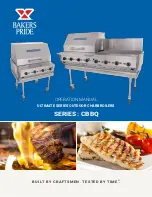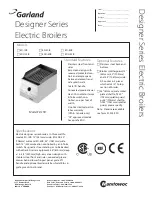
34
XIII Service and Maintenance
a. Water Side Maintenance
the following procedure should be performed on an annual basis:
1) Turn off electrical power and oil supply to the boiler.
2) Inspect the low water cut-off:
•
For Hydrolevel CG450 low water cut-offs - Remove and inspect the probe for scale and sediment buildup. Clean
any sediment or scale from the probe with a scouring pad or steel wool. Consult the Hydrolevel CG450 manual for
any additional maintenance information. Test the low water cut-off before placing the boiler back into service.
3) Allow the boiler to cool to room temperature and drain the boiler. Remove the 1-1/4” plug from the unused return tapping.
Use a flashlight to inspect the bottom row of pushnipples for accumulated scale or mud. If a significant amount is present, use
the following procedure to clean the inside of the heat exchanger:
a) Temporarily install a 1-1/4” inch or larger full port ball valve in place of the 1-1/4” plug. Temporarily pipe the outlet
of this valve to a location where hot water and steam can be safely discharged.
b) Make sure that this valve is closed and that the water level is at the normal water line.
c) If a king valve is present in the steam main takeoff, close it. Alternatively, temporarily replace enough of the vents
on the mains and/or radiators with plugs so that 2-5 psi can be developed when the boiler is fired.
d) Fire the boiler and allow it to steam until 2-5 psi is registered on the gauge.
e) Turn off the burner and immediately fully open the 1-1/4” valve.
f) Allow the boiler to blow down until either the water runs clear or the water level reaches the bottom of the gauge
glass.
g) Allow all parts of the boiler to cool to room temperature. Drain the boiler completely and remove the 1-1/4” valve.
h) If significant mud or scale is still present in the bottom of the boiler, repeat steps (b) through (g) until all mud or
scale is removed.
i) Once all mud or scale is removed, replace the 1-1/4” valve and temporary blow-down piping with the standard plug.
j) After all parts of the boiler are at room temperature, refill the boiler to the normal water line.
nOtE
A large accumulation of mud or scale in the bottom of the heat exchanger is usually a sign of excessive feedwater make-up.
Such accumulations can cause severe heat exchanger damage. If mud or scale accumulations are found:
•
Make sure that all vents are in working order. Vents should not permit any passage of steam or water.
•
Check all steam and return piping for leaks. Be aware that buried return piping can leak and go undetected
during normal operation.
tanKlESS HEatEr MaIntEnancE
•
During the warm months, make sure that the water level in the boiler is 30 to 31-1/2 inches above the surface on
which the boiler is installed. Failure to do this may result in inadequate hot water and/or steaming when there is no call
for heat.
•
Maintain the mixing valve in accordance with the valve manufacturer’s instructions.
Summary of Contents for FSZ080
Page 2: ......
Page 14: ...12 FIGURE 6 4 ALLAIR FROM OUTDOORS USING HORIZONTAL DUCTS INTO BOILER ROOM...
Page 18: ...16 FIGURE 8 1 STEAM BOILER PIPING FOR GRAVITY RETURN...
Page 26: ...24 FIGURE 10 2 TWO PIPE GRAVITY FEED SYSTEM NOT RECOMMENDED FIGURE 10 3 TWO PIPE LIFT SYSTEM...
Page 29: ...27 FIGURE 11 0 WIRING CONNECTIONS DIAGRAM STEAM CG450 PROBE LWCO...
Page 30: ...28 FIGURE 11 1 CONNECTIONS WIRING DIAGRAM FOR BURNER SPECIFIC PRIMARY CONTROL...
Page 31: ...29 FIGURE 11 2 INDIRECT WATER HEATER FIELD WIRING...
Page 41: ...39 Notes...
Page 43: ...41...
Page 45: ...43...
Page 47: ...45...
Page 51: ...Notes...
















































